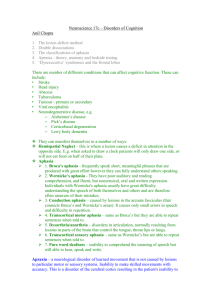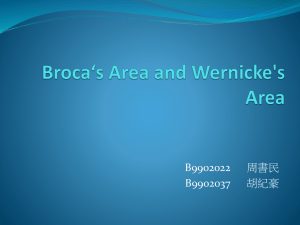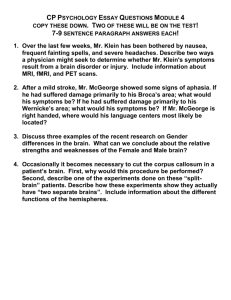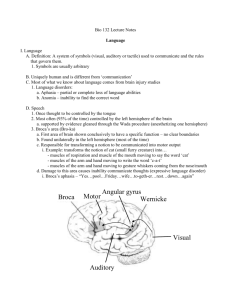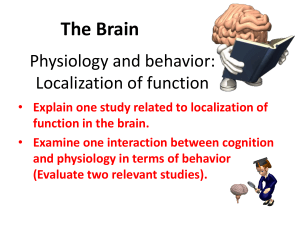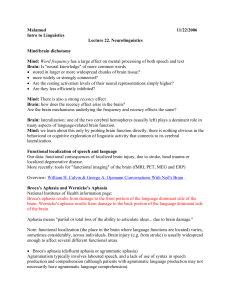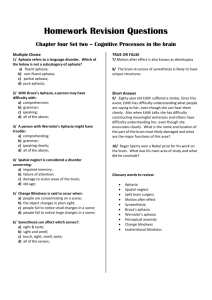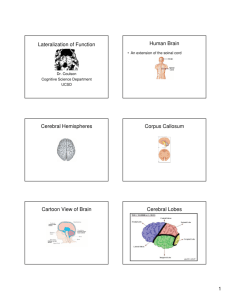quiz0404_DM - UCSD Cognitive Science
advertisement
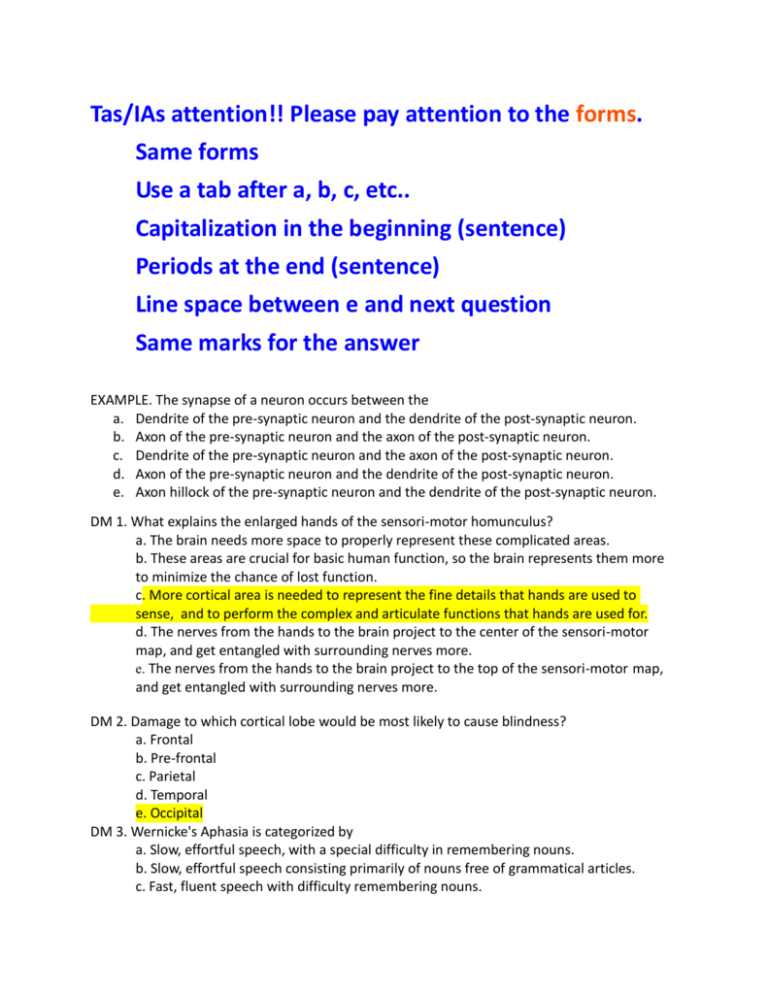
Tas/IAs attention!! Please pay attention to the forms. Same forms Use a tab after a, b, c, etc.. Capitalization in the beginning (sentence) Periods at the end (sentence) Line space between e and next question Same marks for the answer EXAMPLE. The synapse of a neuron occurs between the a. Dendrite of the pre-synaptic neuron and the dendrite of the post-synaptic neuron. b. Axon of the pre-synaptic neuron and the axon of the post-synaptic neuron. c. Dendrite of the pre-synaptic neuron and the axon of the post-synaptic neuron. d. Axon of the pre-synaptic neuron and the dendrite of the post-synaptic neuron. e. Axon hillock of the pre-synaptic neuron and the dendrite of the post-synaptic neuron. DM 1. What explains the enlarged hands of the sensori-motor homunculus? a. The brain needs more space to properly represent these complicated areas. b. These areas are crucial for basic human function, so the brain represents them more to minimize the chance of lost function. c. More cortical area is needed to represent the fine details that hands are used to sense, and to perform the complex and articulate functions that hands are used for. d. The nerves from the hands to the brain project to the center of the sensori-motor map, and get entangled with surrounding nerves more. e. The nerves from the hands to the brain project to the top of the sensori-motor map, and get entangled with surrounding nerves more. DM 2. Damage to which cortical lobe would be most likely to cause blindness? a. Frontal b. Pre-frontal c. Parietal d. Temporal e. Occipital DM 3. Wernicke's Aphasia is categorized by a. Slow, effortful speech, with a special difficulty in remembering nouns. b. Slow, effortful speech consisting primarily of nouns free of grammatical articles. c. Fast, fluent speech with difficulty remembering nouns. d. Fast, fluent speech with lots of neologisms, word-salad, and nonsense words. e. A complete inability to comprehend spoken language, with fully functional speech. DM 4. According to the Wernicke-Geschwind model, which sort of Aphasia is caused by damage to the area responsible for comprehending heard words? a. Wernicke's Aphasia b. Broca's Aphasia c. Production Aphasia d. Conduction Aphasia e. Wada's Aphasia DM 5. Which of the following is true of lateralization of language in humans? a. All right handed people have speech centers in the left hemisphere. b. All left handed people have speech centers in the left hemisphere. c. Most right handed people have speech centers in the left brain, and most left handed people have speech centers in the right brain. d. Most right handed and left handed people have speech centers in the left hemispheres, but a higher percentage of the left handed have their speech centers in their right hemispheres than in the right handed. e. Most right handed and left handed people have speech centers in the left hemisphere, but a higher percentage of the right handed have their speech centers in their left hemispheres than in the left handed. JS 1. The frontal lobe of the brain is often implicated in which of the following functions? a. Sensation, Spatial Cognition, Attention b. Audition, Memory, High-Level Vision c. Motor Control, Language Production, Emotion d. Language Comprehension, Object Recognition e. Vision JS 2. Which of the following statements correctly represents the difference between sexes in incidence of aphasia following traumatic brain injury? a. Women are more likely to suffer from aphasia after parietal and temporal lobe damage, while men are more likely to suffer from aphasia after frontal lobe damage. b. Women are more likely to suffer from aphasia after occipital lobe damage, while men are more likely to suffer from aphasia after temporal and parietal lobe damage. c. Women are more likely to suffer from aphasia after frontal lobe damage, while men are more likely to suffer from aphasia after occipital lobe damage. d. Women are more likely to suffer from aphasia after frontal lobe damage, while men are more likely to suffer from aphasia after parietal and temporal lobe damage. e. Men and women are equally likely to suffer from aphasia after any brain damage. JS 3. Brodmann’s areas are: a. b. c. d. e. Brain regions that have different functions in men and women. The two areas responsible for language comprehension and production in the brain. Regions of the brain that, if damaged, often lead to conduction aphasia. Specific portions of the frontal lobe primarily involved in language processing. Many different brain areas defined by cytoarchitectonic characteristics. JS 4. Paul Broca’s most well-known patient was characterized by an inability to: a. Produce any speech sounds. b. Comprehend instructions or speech. c. Produce any noises other than the sound “tan”. d. Count aloud and move his hands at the same time. e. Remember any new names or faces. JS 5. Broca’s and Wernicke’s aphasics often indicate certain mental awareness of their condition and its effect on their language abilities through their interactions with others. Which of the following statements correctly represents the general trend of their conditions? a. Broca’s aphasics are aware of their deficits, while Wernicke’s aphasics are unaware of their deficits. b. Broca’s aphasics are unaware of their deficits, while Wernicke’s aphasics are aware of their deficits. c. Both Broca’s aphasics and Wernicke’s aphasics are unaware of their deficits. d. Both Broca’s aphasics and Wernicke’s aphasics are aware of their deficits. e. Broca’s and Wernicke’s aphasics will frequently indicate different levels of awareness of their deficits. WC 1. Dr. Coulson showed an image of a person with extremely large lips and hands during her presentation. Which of the following points did she make about this image? a. There is a lot of individual variation across body representations in the human brain, some people have very large tongues, some have very large backs, or very large ankles, etc. b. Certain parts of the body are over represented (i.e. take up more space) relative to their physical size. c. Many parts of the brain - e.g. sensory cortex- are specialized for particular jobs. d. It well represents how our hemispheres are lateralized to the left side. e. Many research studies focus on particular parts of the body. WC 2. Which of the following statement is often true for patients who have damage in Broca's area and patients who have damage in Wernicke's area? a. Broca's area lesions usually lead to deficits in the production of language, whereas Wernicke's area lesions usually lead to deficits in the comprehension of language. b. Broca's area lesions usually lead to deficits in the comprehension of language, whereas Wernicke's area lesions usually lead to deficits in the production of language. c. Patients with Broca's area lesions are typically unaware of their language problems. d. Patients with Wernicke's area lesion usually have no difficulty expressing themselves by writing grammatically complex and coherent sentences. e. Patients with Broca's area lesions usually have no difficulty expressing themselves by writing grammatically complex and coherent sentences. WC 3. The Wada test was described as a. When you anesthetize one hemisphere and test speech ability. b. When you put a person under general anesthesia and examine their EEG. c. An acronym for “Working Associative Disorder Assay.” d. When you show people movies while imaging their brain. e. When you show people different sizes of cubes and ask them to match the sizes. WC 4. Damage to the arcuate fasciculus leads to difficulty in the ability to repeat speech, while the patient is still able to understand and produce speech. The disorder is known as: a. Conduction aphasia b. Broca’s aphasia c. Broca-Wernicke’s aphasia d. Wernicke’s aphasia e. Wada aphasia WC 5. Which brain area was/were not reported as damaged in Leborgne's brain (Broca's famous stroke patient who had a problem in producing words)? a. Temporal lobe b. Occipital lobe c. Frontal lobe d. Parietal lobe e. Limbic system SD 1. Split brain patients have what part of their brain cut? a. Hippocampus b. Corpus Collosum c. Brain Stem d. Amygdala e. Thalamus SD 2. What type of cell is primarily found in the cortex? a. Brain Cells b. Stem Cells c. Pyramidal Cells d. Simple Cells e. Sensory Cells SD 3. What are the hills and valleys of the cortex? a. Sulci and Gyri b. c. d. e. Gyri and Sulci Gyri and Fissure Sulci and Fissure Fissure and Gyri SD 4. Aphasia is the inability to articulate ideas resulting from genetic defects. a. True b. False SD 5. Women are more vulnerable to aphasia in which lobe? a. Frontal b. Temporal c. Occipital d. Parietal
